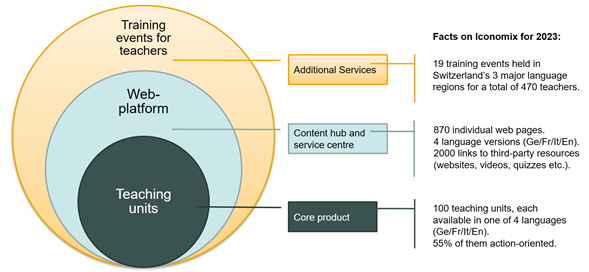Economic and financial literacy is a fundamental life skill for navigating today's complex world. Iconomix offers valuable resources for developing these skills, with a focus on experience-oriented teaching and learning materials.
This article addresses two key questions: Why and how?
Iconomix is an educational programme developed by the Swiss National Bank (SNB). Its aim is to promote economic and financial literacy at Swiss upper secondary schools. To achieve this, Iconomix offers high-quality teaching units for use in economics and general studies classes, which are available on a web platform.
Unlike similar programmes, Iconomix is not aimed at students and learners themselves, but at their teachers as multipliers and gatekeepers. There are just over 4,200 teachers of economics and general studies at Swiss upper secondary schools, providing a clearly defined, manageable target group.
The advantage of this indirect approach is that the teaching staff, unlike the student population, remains relatively constant over time – which is a great advantage for us as a provider.
One disadvantage of focusing on teachers rather than students is that Iconomix has no control over how the provided teaching material is used in the classroom. However, we do not consider this to be a cause for concern.
We believe that the use of the materials in the classroom is the responsibility of the teachers, who are trained and specialized for this task. Moreover, teachers know their students better than anyone else. Our aim at Iconomix is not to interfere in this process but to support teachers in doing their job as well as possible.
Fifteen years after its launch, Iconomix is currently used by 40 percent of its target group, with similar penetration rates across all regions of Switzerland (German-speaking, French-speaking, and Italian-speaking). This makes it the most frequently used supplementary educational programme at the Swiss upper secondary level.
Iconomix's core product consists of approximately 100 teaching units, each available in one of four languages: German, French, Italian and English. The English units are specifically designed for bilingual education in Switzerland.
Each teaching unit is a bundle, consisting of a so-called ‘highlight’ – for example a classroom game –, a set of practical exercises and learning tasks (with sample answers for the teachers), support materials for teachers (presentations, game instructions, additional didactic notes), and links and videos on the topic. The whole service is free of charge. However, registration as teacher is required for some services (e.g., the sample answers to the exercises and tasks).
Teachers use Iconomix resources in addition to their own materials and the existing economics and general studies textbooks. As a result, a teacher rarely uses the whole package, but may select two or three units per year. This cherry-picking by teachers is intentional, as Iconomix is designed to complement the curriculum, not replace it.
The focus of Iconomix is on economics and personal finance, with a special emphasis on current issues and challenges for society.
Iconomix offers materials and interactive tools to illustrate complex economic concepts. Students learn how the economy works and develop their economic thinking.
When it comes to personal finance, Iconomix provides accessible instructions and resources to help students gain a solid grasp of the basics and learn how to manage money.
Iconomix works on the principle of active problem-based learning, with around half of the teaching units being activity-oriented. This process allows students to not only learn facts but also – and above all – the skills needed to apply them.
Iconomix places particular emphasis on quality and innovation. Each unit is evaluated in the course of its design and ongoing development.
The Iconomix programme was launched in 2007. It is fully financed and supported by the SNB.
In 2011, the bank management established a guideline to limit basic funding for third-party services to CHF 0.7 million per year (approximately EUR 0.7 million). They also set a staffing limit for the responsible unit at 3.6 full-time equivalents plus two interns. This allocation of financial and human resources has proven to be effective and sustainable over time.
Iconomix is a web-based programme, with the entire initiative centred around its web platform. This also serves as the main channel of communication with the target group, namely teachers.
However, direct interaction with the teachers is also a key aspect of the programme. This occurs primarily through the organisation of training events and symposia, which may be held on-site as physical events or as video conferences.

Given that over 90% of young people in Switzerland complete upper secondary level schooling, the student population is representative of the country's overall population heterogeneity. This means that there are significant discrepancies between students in terms of cognitive abilities and prior knowledge. Similarly, the needs and methodological preferences of teachers vary considerably.
Furthermore, Iconomix has a presence in all three language regions of Switzerland. Given that these language regions differ not only linguistically but also culturally, this introduces another layer of heterogeneity to an already diverse target group of teachers and students at the upper secondary level.
Iconomix therefore provides comprehensive coverage of a wide range of topics, didactic methods, teaching scenarios and approaches to economic education.
Further information on Iconomix, including current key figures, can be found in the SNB's sustainability report (Chapter 5) and on iconomix.ch in the ‘About us’ section.
In German, French and Italian, the name "Iconomix" is pronounced like the English word "economics". In these languages, then, the name is a playful version of the term "economics."
